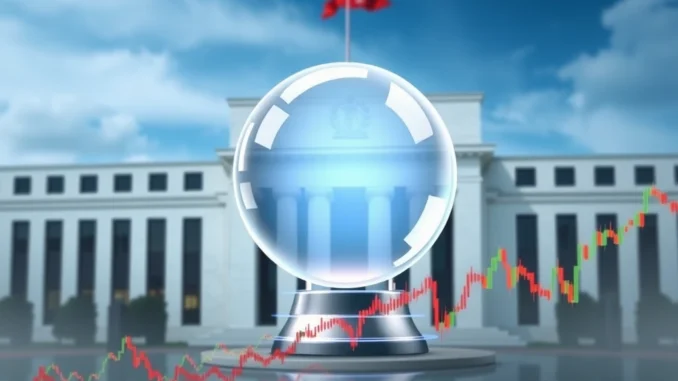
In a stunning turn of events, or perhaps a crystal-clear foresight into the financial future, users of the decentralized prediction market platform, Polymarket, are making waves with an astounding prediction. They’re not just suggesting, but confidently wagering, that there is a 100% chance the U.S. Federal Reserve (Fed) will halt its Quantitative Tightening (QT) policy before the calendar flips to May. Yes, you read that right – a perfect score in the prediction game, at least according to Polymarket participants. This bold forecast, reported by Cointelegraph, has ignited discussions across the crypto and finance spheres, especially with a staggering $6.2 million already traded on this very proposition. Let’s dive into what this prediction means, why it’s grabbing headlines, and what it could signal for the markets.
Decoding the 100% Crypto Prediction: What Does It Mean?
A 100% prediction in any market is eye-catching, to say the least. In the world of crypto and finance, where volatility is often the only constant, such certainty is almost unheard of. But what exactly are Polymarket users predicting, and why should we pay attention?
- Unwavering Confidence: The 100% figure isn’t just a casual guess; it represents a strong consensus among Polymarket users who are putting their money where their mouth is. This level of agreement suggests a deeply held belief within this particular market segment.
- Specific Timeline: The prediction is focused on a clear timeframe – before May. This specificity makes the prediction testable and adds weight to the assertion. It’s not just saying QT will end ‘eventually,’ but within a defined and relatively short period.
- Significant Trading Volume: The $6.2 million trading volume is not insignificant. It indicates substantial participation and conviction behind this prediction. People are actively engaging and investing based on this outlook.
But to fully grasp the implications, we need to understand the key players and concepts at play.
What is Polymarket and Why Does It Matter?
Polymarket is a decentralized prediction market platform built on blockchain technology. Imagine a betting market, but instead of sports or elections, you’re wagering on the likelihood of future events – in this case, economic policy decisions. Here’s why Polymarket stands out in the crypto space:
- Decentralization and Transparency: Being decentralized, Polymarket operates outside traditional financial systems, offering transparency and reducing the risk of manipulation. All transactions and predictions are recorded on the blockchain, making them publicly verifiable.
- Real-time Insights: Prediction markets like Polymarket can act as real-time gauges of public sentiment and expectations regarding future events. They aggregate the collective wisdom of participants, potentially offering more accurate forecasts than traditional polls or surveys.
- Diverse Range of Topics: Polymarket covers a wide array of topics, from political outcomes and tech events to, crucially, economic and financial predictions like the Fed’s policy decisions.
- Incentivized Accuracy: Users are incentivized to make accurate predictions because their financial gains depend on it. This creates a market-driven mechanism for forecasting, potentially leading to more reliable insights.
In essence, Polymarket offers a unique window into market expectations, especially within the crypto-savvy community, and their prediction market data can be a valuable tool for understanding broader trends and sentiments.
Quantitative Tightening (QT) Explained: The Fed’s Policy Under Scrutiny
At the heart of this 100% prediction lies the concept of Quantitative Tightening (QT). But what exactly is QT, and why is its potential end such a significant market event?
Quantitative Tightening is the opposite of Quantitative Easing (QE). Think of QE as the Fed injecting liquidity into the economy by buying assets, primarily government bonds and mortgage-backed securities. QT, conversely, is the Fed reducing its balance sheet by:
- Stopping Reinvestment: When bonds held by the Fed mature, instead of reinvesting the proceeds into new bonds, the Fed simply allows them to roll off its balance sheet.
- Potentially Selling Assets: In some cases, the Fed might actively sell assets in the open market, further reducing its holdings and pulling liquidity out of the system.
Why does the Fed use QT?
- Combating Inflation: QT is a tool used to combat inflation. By reducing the money supply and liquidity in the market, the Fed aims to cool down the economy and bring inflation under control.
- Normalizing Monetary Policy: After periods of QE, QT is often used to normalize monetary policy and reduce the Fed’s footprint in the financial markets.
Impact of QT on Markets:
- Increased Borrowing Costs: QT can lead to higher interest rates as liquidity decreases, making borrowing more expensive for businesses and consumers.
- Potential Market Volatility: The unwinding of QE can sometimes lead to market volatility as investors adjust to tighter financial conditions.
- Impact on Asset Prices: QT can put downward pressure on asset prices, including stocks and potentially cryptocurrencies, as liquidity becomes scarcer.
Therefore, the end of QT is generally seen as a potentially positive signal for markets, suggesting a shift towards a more accommodative monetary policy, or at least an end to the tightening cycle.
Why Fed Ending QT Could Be Imminent: Analyzing the Prediction
So, why are Polymarket users so confident about the Fed ending QT before May? While a 100% prediction should always be viewed with a degree of skepticism, several factors could be contributing to this strong sentiment:
- Inflation Trends: Recent inflation data might be suggesting a cooling trend. If inflation starts to show signs of easing, the pressure on the Fed to continue aggressive QT might diminish.
- Economic Slowdown Concerns: Aggressive QT can risk slowing down economic growth too sharply, potentially leading to a recession. If economic indicators start to weaken, the Fed might be inclined to pause or reverse QT to support the economy.
- Market Stability: Financial market conditions play a crucial role. Significant market stress or instability could prompt the Fed to reassess its QT policy to prevent further disruptions.
- Lagged Effects of Rate Hikes: The Fed’s interest rate hikes take time to fully impact the economy. There’s a possibility that the Fed believes the lagged effects of previous rate hikes, combined with existing QT, will be sufficient to manage inflation, reducing the need for continued QT.
- Anticipation of Policy Shift: Market participants might be anticipating a shift in the Fed’s stance, perhaps based on Fed communications, economic forecasts, or a general sense that the tightening cycle is nearing its end.
It’s important to note that while Polymarket predictions offer valuable insights into market sentiment, they are not infallible. Economic conditions and Fed policy decisions are complex and can change rapidly. However, the sheer conviction reflected in this 100% prediction warrants serious consideration.
The Potential Market Impact: What Happens if the Federal Reserve Ends QT?
If Polymarket’s prediction proves accurate and the Federal Reserve does indeed end Quantitative Tightening before May, what could be the potential ramifications for the markets, particularly the crypto market?
- Positive for Risk Assets: Historically, the end of tightening cycles and the anticipation of easier monetary policy have been positive catalysts for risk assets like stocks and cryptocurrencies. An end to QT could signal a more favorable environment for these assets.
- Increased Liquidity: Halting QT means the Fed is no longer actively draining liquidity from the market. This could ease financial conditions and potentially boost asset valuations.
- Dollar Weakness: A less hawkish Fed stance could potentially lead to a weaker US dollar, which can sometimes be beneficial for cryptocurrencies, particularly Bitcoin, as it’s often seen as an alternative to fiat currencies.
- Boost to Crypto Markets: Given the crypto market’s sensitivity to macroeconomic factors and liquidity conditions, an end to QT could provide a significant boost. It might be interpreted as a signal that the tightest financial conditions are behind us, encouraging renewed investment in crypto.
- Inflation Rebound Risk: However, it’s crucial to consider the potential downside. If the Fed ends QT prematurely and inflation remains stubbornly high or even rebounds, it could necessitate a return to tightening policies later, potentially leading to further market volatility and uncertainty.
Ultimately, the market reaction will depend on the broader economic context at the time, including inflation levels, economic growth, and the Fed’s communication regarding future policy intentions.
Conclusion: Is 100% Certainty in Crypto Prediction Realistic?
The 100% crypto prediction on Polymarket regarding the Fed ending Quantitative Tightening before May is undoubtedly a bold and attention-grabbing statement. While absolute certainty is rarely found in financial markets, especially in the volatile world of crypto, this prediction reflects a strong market sentiment worth acknowledging.
Whether this prediction materializes or not, it highlights the growing influence of decentralized prediction markets like Polymarket as tools for gauging market expectations. It also underscores the intense scrutiny and analysis surrounding the Fed’s monetary policy and its potential impact on all asset classes, including cryptocurrencies.
As we move closer to May, all eyes will be on the Fed’s actions and pronouncements. Will Polymarket users be proven right in their unwavering prediction market forecast? Only time will tell. But one thing is certain: this prediction has sparked a crucial conversation about the future direction of monetary policy and its implications for the financial landscape.



